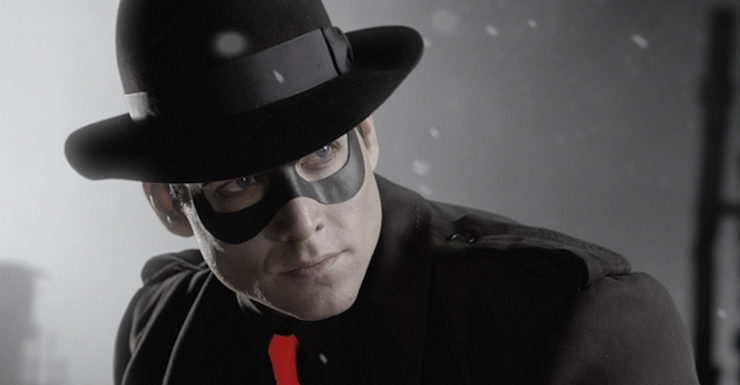While there are other people who qualify for the title, it isn’t hyperbole to say that Will Eisner is one of the greatest comic book artists in the history of the world. Co-founder of the Eisner-Iger Studio that produced a ton of comic strips and comic books in the 1930s, Eisner was hired in 1939 by Quality Comics to create a sixteen-page Sunday supplement to the comic strips section that would tell full-on comic-book style stories. Eisner created a masked hero who fought crime nicknamed “the Spirit.” The Spirit quickly became hugely popular throughout the 1940s, and it ran in Sunday newspapers until 1952.
Lots of attempts were made to bring the Spirit to radio, film, and television, but only two actually made it to the screen, only one of which aired in Eisner’s lifetime: a pilot for a TV show in 1987 that wasn’t picked up, and a 2008 feature film.
The Spirit is a former Central City cop named Denny Colt, who is believed to be dead. Wearing a domino mask to disguise his identity, he continues to fight crime as the Spirit. Police Commissioner Dolan knows his real identity and works with the Spirit to fight the various criminals who torment Central City.
Eisner’s stories of urban crime and espionage combined with his groundbreaking work in panel design and atmospheric artwork to create an enduring set of stories that work as ground-level pulp and high art at the same time. The Spirit was dubbed by one critic as the world’s only middle-class hero, which was actually true at the time. Superman was a jet-setting journalist, Batman a wealthy socialite, Wonder Woman and Sub-Mariner were both royalty, the Human Torch was a robot, and Captain America was actually lower-class. The Spirit was just a regular Joe who fought crime with his brains and with his fists.
At a time when most comic book companies were mass-producing superhero and war material, and nobody was concerned with making art, Eisner stood out, as he pushed the envelope in terms of layout and design and atmosphere. He changed the way you could do sequential art, and has continued to influence virtually all comics that have been done since. (Not coincidentally, some of the finest artists in comics history came out of the Eisner-Iger studio, some of whom later worked with Eisner on The Spirit: Jack Kirby, who co-created most of Marvel’s iconic characters; Jules Feiffer, later to become one of the great political cartoonists; Wally Wood, a mainstay of Mad Magazine; Bob Kane, co-creator of Batman; and more.)
After several false starts, including negotiations for a movie serial in the 1940s that never went anywhere, and an animated movie directed by Brad Bird that never got out of development, CBS produced a pilot for a Spirit TV series in 1987 starring Sam Jones, best known for the title role in 1980’s Flash Gordon. It was adapted by Steven de Souza, probably best known as one of the writers of Die Hard, and would go on to adapt Judge Dredd for Sylvester Stallone. It didn’t go to series, and almost didn’t air, but urging from comics fans got it aired, at least, and it received a small home video release. Eisner himself was reportedly displeased with how the pilot came out.
In 2008, three years after Eisner’s death, Frank Miller—the comics creator who turned Daredevil into an A-list character, revitalized Batman, and who had had success collaborating with Robert Rodriguez on a live-action adaptation of his noir comic book series Sin City—got the rights to do a Spirit movie. Miller considered Eisner to be a father-figure and mentor, and saw this as a labor of love, which may come as a surprise to anyone who has both read the comics and seen the movie…
“Murder is never a laughing matter”
The Spirit
Written by Steven E. de Souza
Directed by Michael Schultz
Produced by Stu Samuels & Frank von Zerneck
Original release date: July 31, 1987
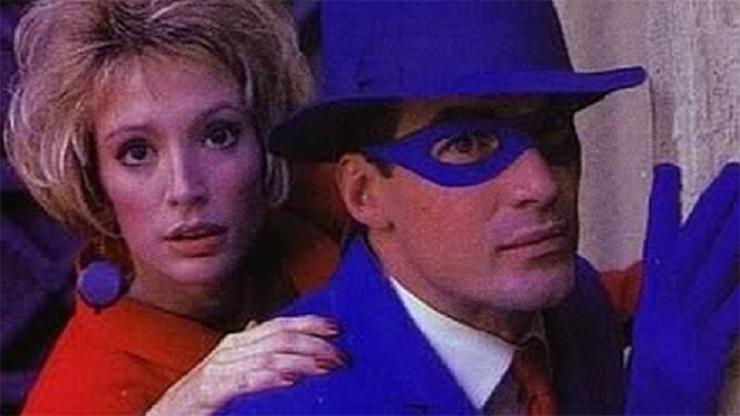
Denny Colt, a straight-arrow cop in Armfet, Oregon, drives to the house of his mentor and best friend, retired cop William Sevrin. Sevrin was working on a manuscript about the Roxton Museum in Central City. An unknown assailant broke into his house and burned it down, fatally clubbing Sevrin on the head and burning his manuscript. Sevrin’s dying words are that only two people knew about the book: Colt and Simon Teasdale, the curator of the Roxton, to whom Sevrin wrote a letter.
Teasdale is now at worst a suspect and at best a person of interest, so Colt goes to Central City. He finds Commissioner Dolan at a charity event hosted by his daughter Ellen and her best friend P’Gell Roxton. (On the way, Colt foils a purse snatching, and also catches a kid named Eubie who’s peddling hot tape players; since Eubie is peddling the tape decks to disadvantaged kids, Colt lets him go.)
Dolan tells Colt to make an appointment, as you don’t just haul in someone like Teasdale for questioning in a murder, but Colt refuses to wait and goes straight to the museum. Teasdale is not really interested in answering Colt’s questions, and also denies ever receiving a letter from Sevrin. In addition, he can’t imagine what Sevrin’s book could possibly be about, as the museum’s never been the subject of any criminal activity, not even vandalism.
One of the museum workers, a guy named Bruno, says he may know something that will help Colt, but he can’t talk about it there. He and Colt agree to meet at Pier 10—where Bruno shoots Colt.
While Colt’s badge is found near a bloodstain on the pier, no body is recovered. And Colt himself stumbles to a cemetery—where he bumps into Eubie and his dealer. The dealer runs away, but Eubie actually nurses Colt back to health in a sarcophagus. Colt decides to let the world believe he’s dead. He puts on a domino mask that somehow keeps everyone from recognizing him and he starts to fight crime in this city he’s only been in for less than a week.
Besides making this city that is not his home safer (crime is down 21% over the time he spends stopping jewel heists and muggings and such), he also tries to find out more about Roxton. He also introduces himself to Dolan, to whom he reveals that he’s really Colt. Since the Spirit, as he’s been nicknamed, has done some good, Dolan allows him to continue working. Ellen also meets him, but both the Spirit and Dolan refuse to reveal his true identity to her for no compellingly good reason.
Spirit figures that Roxton is counterfeiting artwork, and he learns that they’re doing the work in the museum basement. He breaks in through the women’s room just as Ellen enters. Spirit fears for her life, and he helps her escape through the window before either of them remember that she was there on official business (she’s the police force’s liaison to the mayor’s office) and she could’ve just walked out the front door.
Spirit discovers the counterfeiting operation, and fisticuffs ensue, but Spirit is bonked on the head by Bruno. He’s left in a deathtrap—being lowered into the acid bath they use to age the fake sculptures—but Ellen decides to check up on him, and manages to rescue him.
He still doesn’t have concrete evidence, so he sets a trap: disguising himself as a professor, he meets with Teasdale and P’Gell to discuss museum matters, and offhandedly mentions that he has a copy of Sevrin’s manuscript.
Bruno and two thugs follow Spirit to the graveyard, and more fisticuffs ensue. Unbeknownst to our heroes, however, Teasdale isn’t the bad guy—P’Gell is. The counterfeiting scheme is hers, and after Bruno once again knocks Spirit on the head, P’Gell ties him up in the basement of the museum. He refuses to say where the manuscript is, but in his unconscious stupor after Bruno hit him, he called Ellen’s name. So P’Gell kidnaps Ellen from the party being held for disadvantaged kids in the museum and threatens her life, at which point Spirit admits that there is no manuscript, he just used that to call her out.
Since there’s too much heat on her now, P’Gell plans to blow up the museum and cut her losses. Spirit manages to break out of his bonds and stop all the bombs, as well as having one final fistfight with Bruno, which takes him all the way to the giant dinosaur cake in the middle of the party.
P’Gell gets away, and Teasdale is using the publicity from this to raise the museum’s profile. Meanwhile, Spirit will continue to fight crime in this city that has nothing to do with him at all.
“I don’t like egg on my face!”
The Spirit
Written and directed by Frank Miller
Produced by Deborah Del Prete & Gigi Pritzker & Michael E. Uslan
Original release date: December 25, 2008
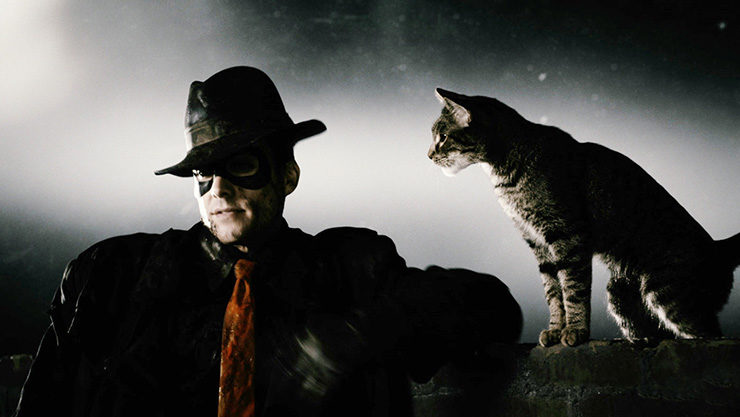
The Spirit gets a call from one of the Central City cops he trusts, Detective Sussman, saying a shady deal is going down. The Spirit goes, while providing an endless tough-guy voiceover about his city that sounds like a cross among Batman, Daredevil, and the Stephen Amell version of Green Arrow.
Sussman confronts a woman who rises, Lady-of-the-Lake-like, out of the water and holds a gun on him—but it’s the Octopus, a major criminal who controls most of Central City’s drug trade, who shoots Sussman. The woman, Sand Serif, dives back underwater and retrieves the two boxes she’s come to collect. The Octopus shoots at her and her partner/husband, hitting only him, then dives underwater and shoots some more, breaking the chain linking the two boxes. Serif gets away with one of them, while the Octopus claims the other.
The Spirit arrives just as Octopus resurfaces, and the two of them have a huge fight that involves a disturbing amount of diving into mud. Also at one point, the Octopus conks the Spirit on the head with a toilet, and if that isn’t a metaphor for this film, I don’t know what is!
After the Octopus makes some oblique remarks about how much alike they are, and how it’s significant that both of them heal quickly from injuries that would kill a normal person, he buggers off.
Sussman pulled a locket off of Serif, and he gives it to Spirit before he dies. Spirit recognizes it as belonging to Serif, who was his childhood sweetheart, back when he was just a kid named Denny Colt. Colt’s father was a drunk boxer who accidentally shot Serif’s father, a cop. Serif—who always wanted shiny things—was embittered by her father’s death, declared that she hated cops, and left Central City never to return—until now, anyhow—becoming a jewel thief.
Serif meets with her fence, who betrayed her to the Octopus. In her anger, Serif convinces the fence to kill himself.
Spirit gets fixed up by Dr. Ellen Dolan, and then they have a brief moment of smooching that’s interrupted by her father, Police Commissioner Dolan. Dolan introduces them to an enthusiastic rookie cop, Officer Morgenstern.
Dolan doesn’t care about the Octopus, he’s more concerned with Serif. Even though Dolan knows that Spirit is really Colt, Spirit lies and says he doesn’t know Serif. To Dolan’s credit, he doesn’t believe him.
Spirit, Dolan, and Morgenstern check out the crime scene of the fence’s murder, then Spirit goes off on his own, asking Morgenstern to let him know if there are any leads on the Octopus.
It turns out that what Serif really wanted was in the box that the Octopus got and what Octopus really wanted was in the box Serif has. Serif gets into a card game with one of the Octopus’s associates, and when she cleans him out, she asks that he pass on a message to the Octopus that she wants to meet.
Spirit guesses that Serif would be staying at the nicest hotel in town, and he finds her and the corpse of her latest husband there. The husband supposedly killed himself. For some inexplicable reason, Spirit doesn’t mention that he has her locket, and Serif—like everyone else—doesn’t realize that Colt and Spirit are one and the same even though they look and sound alike.
Morgenstern notices that the corpse of one of Octopus’s cloned henchmen had industrial salt on his boots. Spirit checks out the Feiffer Industrial Salt Company, and finds Octopus’s headquarters under it. However, his associate, Silken Floss, injects him with a sedative, and they tie him up.
The Octopus reveals that he created the Spirit. He created a fluid that allows one to heal quickly. Back when he was the coroner, he tested it on Officer Denny Colt after he was shot. Once he saw it worked, he injected it into himself. His next step is to obtain the blood of Heracles, which will make him immortal, which is what he needs from Serif. (Serif wants the Golden Fleece, which Octopus currently has.) He plans to kill the Spirit by slicing off bits of him and separating them far enough that he can’t regenerate.
However, Plaster of Paris, a woman in a bellydancer outfit whom Octopus wants to kill him, turns out to be an ex-fling of the Spirit’s, so she frees him out of love for him. Spirit beats the crap out of Octopus, and mentions Serif, which makes Paris jealous, so after she frees him, she impales him with her sword.
Spirit overheard where Serif and Octopus plan to make their exchange. Serif and Floss banter a bit—Serif tries to convince Floss to get away from Octopus, but Floss is having too much fun—and then Octopus appears. All hell breaks loose, as Dolan, Morgenstern, and the other cops open fire, as does Octopus, and Spirit appears, and it’s a big ol’ mess. When Octopus tries to drink Heracles’s blood, Serif shoots the vase. Spirit drops a grenade down Octopus’s shorts, and Serif uses the Fleece to protect herself and Spirit from the explosion. Because she saved his life, Spirit convinces Dolan to let Serif get away—and Serif also realizes that Spirit is her childhood sweetie. Spirit gives the locket back to her and she buggers off, while Spirit insists that he only loves Ellen, who doesn’t entirely buy it.
Meanwhile, Floss retrieves one of Octopus fingers, and figures she can start over with that.
“We was watchin’!”
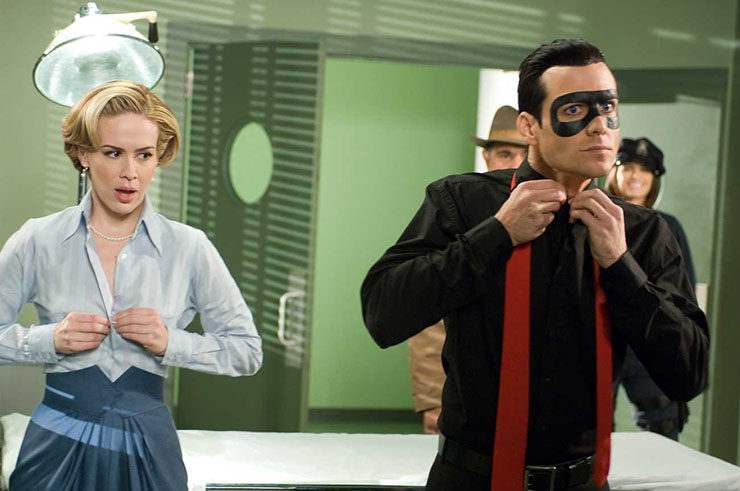
(For the purposes of this review, I’m going to refer to the 1987 pilot as “the Jones film” and the 2008 movie as “the Macht film,” and “the Spirit” will simply refer to the main character. Cha cha cha.)
When the Macht film was released, I remember reading a comment on a friend’s blog that it would’ve been simpler if Frank Miller had simply dug up Eisner’s grave and pissed directly into his skull.
And he wasn’t far off. Back in 2008, Miller was quoted as saying this on Sci-Fi Wire: “Will Eisner was my mentor, and The Spirit was so awesome a property that I at first thought I was not worthy to do it.” All I can think is that he should’ve gone with his first instinct.
There are several problems here: the disjointed pacing, the too-dark lighting, the incoherent scripting, the mediocre acting from the lead… It’s just really poor, and not even poor in a good or fun way, just a sort-of stare-at-the-screen-and-go-“buh???” way.
We start with the visuals, which are just wrong. The stylized flat noir style that served Sin City so perfectly is an abject disaster when adapting The Spirit. For all the noir trappings of Eisner’s comics, the art was always fairly bright. Muting the colors doesn’t do the Macht movie any favors. (Neither did covering Spirit and Octopus in mud for most of the first half-hour. First time I saw this movie on DVD in late 2009, I almost stopped watching after the conking on the head with the toilet, which remains the perfect metaphor for this mess.)
Also, there’s no sense of whimsy here. Yes, Eisner wrote about a guy who cheated death and fought crime and engaged in lotsa violence, but it was always fun. Fun has never been Miller’s strong suit, and he wouldn’t know whimsy if it bit him on his behind.
There are good points: Sarah Paulson was born to play Ellen; Louis Lombardi is hilarious as multiple similarly named, not-too-bright, cloned thugs of the Octopus’s; and Stana Katic is marvelous as the eager-to-please Morgenstern, a Bizarro-world version of Castle’s Kate Beckett. Plus, Scarlett Johansson knocks it out of the park as Floss, as the Black Widow turns out to be a way more effective villain than Nick Fury.
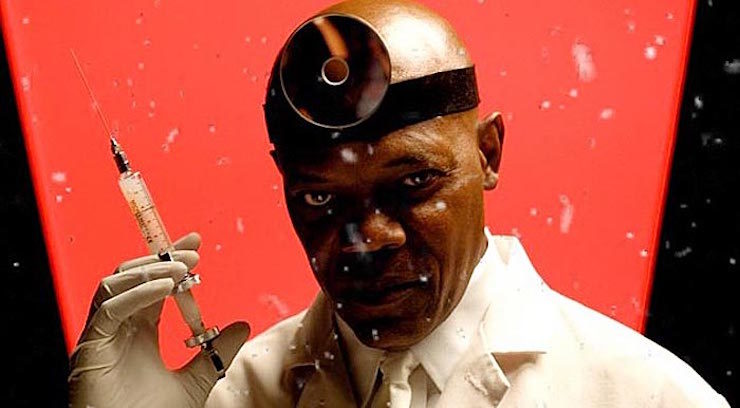
This isn’t the worst use of Samuel L. Jackson—George Lucas’s utter inability to make Mace Windu interesting will always have that place of honor—but it’s right down there. Jackson’s at his best in two modes: utter, frightening calm (viz. Fury) or manic insanity (viz. Valentine in Kingsmen: Secret Service). Sometimes he does both (viz. Jules in Pulp Fiction). Miller manages to find a weird middle ground that’s too manic for Jackson’s calm mode but too calm for his manic mode.
Dan Lauria is perfect casting for Dolan, but his performance doesn’t work, mostly because he spends too much time yelling at the Spirit for being a skirt-chaser—something, by the way, that the original never was. Nor was he a brooding, violent, grimdark hero who waxes rhapsodic about his city. Overall, Macht is just a disaster in the role. To be fair, he has nothing to work with, since Miller has changed him from Eisner’s middle-class hero into—well, basically, every other Frank Miller protagonist ever.
Sam Jones, at least, looks and sounds like the Spirit. He’s got the blue suit and especially the physicality. Eisner always drew the Spirit as the biggest guy in the room, and Macht never comes across that way, but the 6’3″ Jones absolutely does.
Sadly, while Jones is a much better visual for the part, his movie is just as big a disaster. Where the Macht film is too dark, the Jones film is too bright. Just as Howard the Duck suffered from the transition from the 1970s to the 1980s, so too with The Spirit, which comes across as off-kilter four decades removed from its creation. (The Macht film is sufficiently stylized that this is less of a problem—the movie occupies a weird limbo with pop-bulb flashes and 1940s fashions, but also with cell phones and computers, but that, at least, actually works.)
Jones tries his best, at least, as does Nana Visitor as Ellen, who is saddled with dumb dialogue, dumber drooling over the Spirit, and the dumbest slapstick bit in all creation in the scene in the museum women’s room. Visitor gamely does the best she can, but she’s saddled with just a terrible characterization.
Visitor, Jones, and Daniel Davis as Teasdale are the only ones who are actually trying here. Davis does a wonderful job of making you think that Teasdale’s the bad guy. (Anyone who knows the comics knows it’s a fakeout, as P’Gell is a recurring antagonist in the comics, but the double-reverse on the bad guy mostly works anyhow.) Everybody else is wretched, from Garry Walberg’s bloodless Dolan to McKinlay Robinson’s dreadful P’Gell to Bumper Robinson, who is just as awful as the pre-teen Eubie (a poor attempt to redo the comics’ Ebony White, a black character who has aged really really badly) as he will be as a teenager in Generation X in the following decade.
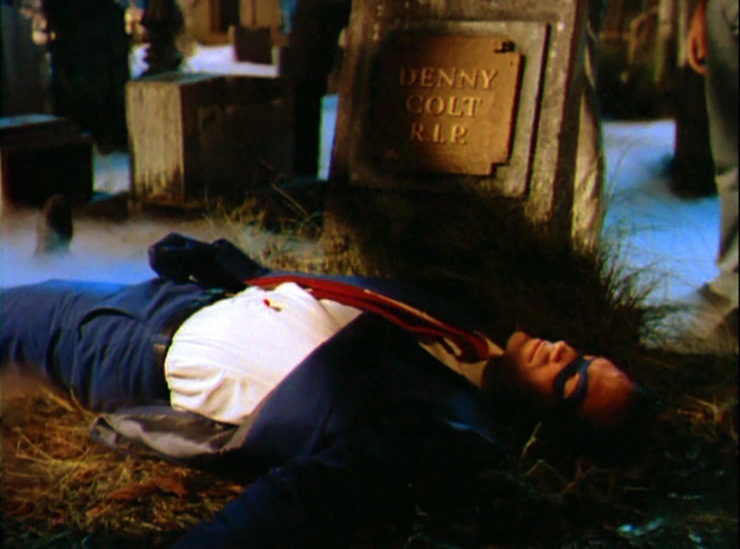
Both movies suffer from an inability to get the source material. The Jones film just glosses over the surface of the events of the comics, but doesn’t really commit to it beyond Jones uttering the lamest of clichés. Both movies have some spectacularly wretched dialogue, both make changes to the source material that make the story significantly worse. The Jones film has Colt be from another city, which makes his becoming a vigilante out to save Central City nonsensical. (Also the running joke where people misread his badge as being from “Armpit” rather than “Armfet” went on a bit too long.) And the Macht film turns the square-jawed hero of Eisner’s comics who was mostly befuddled by women into a skirt-chasing asshole who monologues broodingly. Plus we actually see the Octopus—he was always off-panel in the comics—and he spends the whole movie cosplaying: as a weird cowboy, a samurai, a Nazi, and a 70s pimp. And why does he have such an obsession with eggs, exactly?
The Jones film, at least, is paced rather briskly, and events move sensibly, plus it has the Spirit’s signature ripping of his suit on a regular basis (yet the mask is never out of place). The Macht film is all over the place, disjointed and difficult to watch, while his clothes are barely rumpled, much less torn (though Paris cuts his tie off at one point). Both of them are disastrous adaptations of one of the finest examples of comic art of the 20th century, and neither deserves to be how Eisner’s most famous creation is remembered. With luck, the Macht film will fall into the same obscure dustbin that the Jones film did—ironically, the imminent release of the Macht film a decade ago brought the Jones film back to prominence from the bootleg-VHS peanut gallery it had been consigned to.
Next week, we look at the opening act of Marvel’s movie renaissance, the Blade trilogy starring Wesley Snipes.
Keith R.A. DeCandido will be an author and musical guest at Farpoint 25 in Cockeysville, Maryland this weekend, alongside The Spirit co-star Nana Visitor and Generation X co-star Matt Frewer, as well as fellow authors Timothy Zahn, Peter David, Robert Greenberger, David Mack, Marc Okrand, Aaron Rosenberg, Howard Weinstein, and tons and tons more. Check out his schedule here.










